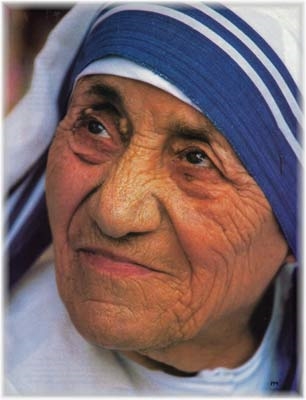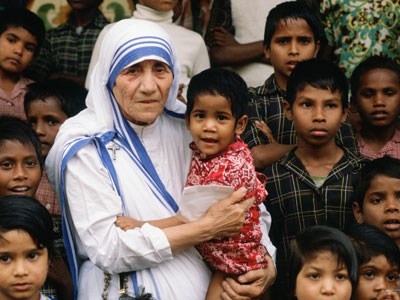There are people everywhere. Children, lining the alleys, engrossed in the uninfluential games they play to pass the time; men, lounging around with nothing better to do, occasionally bursting out in raucous laughter and boisterous singing; and women, screaming in their attempts to be heard, rushing around with their hands full, and above all, trying to keep things organized and clean. It’s a useless mission. For these are the slums of Calcutta, India. Those who live here are those who have no other choice. There’s a desperation and hopelessness that pervades these streets, seeping into the very soul of the community. Here, it’s a fight to the death for the right to live. But within this bleak and miserable environment, there’s still some hope to be found. And oddly enough, it comes in the form of a single woman, barely five feet tall, painfully inconspicuous, and armed with nothing but pure will and determination. Mother Teresa: renowned for her immense personal sacrifice and relentless dedication to her cause, her respect and kindness to those around her, despite their outcast statuses and desperate situations, and for the powerful inspiration she provided, and still does provide, to people around the world.
 |
| Mother Teresa (http://sarcasticredheadgeek.files.wordpress.com/2009/11/mother-teresa.jpg) |
Mother Teresa, born Gonxha (Agnes) Bojaxhiu, on August 27, 1910 in Skopje, Yugoslavia, showed an interest in helping others from childhood. At the age of eighteen, she traveled to Dublin, Ireland to join the Sisters of Loreto, a women’s Catholic religious order active on every continent. Upon becoming a nun, she took the name ‘Teresa’, in honor of Teresa of Avila and Theresa of Lisieux, and immediately set out for Calcutta, India to teach at St. Mary’s High School. In 1946, she decided to do something more meaningful with her life and in 1948, she founded the Missionaries of Charity, an order committed to serving the poor and the less fortunate. Soon, there were thousands of members running centers for orphans, lepers, the blind, the disabled, the dying, alcoholics, drug addicts, and the homeless (Parello). Mother Teresa was met with international acclaim, winning multiple awards before receiving the 1979 Nobel Peace Prize. Despite her huge success, however, her health began declining as she suffered several heart attacks and broken bones. Finally, on September 5, 1997, she passed away in her beloved Calcutta and Sister Nirmala was named her successor (“Teresa, Mother”). Several years after her death, Pope John Paul II beatified her, leaving her one step away from sainthood.
 |
| Calcutta Slums (http://www.foundersacademy.org/Gallery_Sheryl_India/slums/Calcutta-slums.jpg) |
One of Mother Teresa’s greatest attributes was the way she gave up everything to help those less fortunate and never took credit for her work, always searching to inform the world, not of what she did, but of what could still be done. “She has received each award…in the name of the poor and suffering and those who seek to help them” (“Mother Teresa”). Mother Teresa didn’t particularly care for rewards or payment because she felt that helping a fellow human being equaled and surpassed the hard work she put into her cause. In fact, instead of seeking praise and gratitude for her efforts, Mother Teresa consistently deflected attention off of herself and onto those who needed her, constantly thinking of how to continue helping the poor and impoverished. This was demonstrated when she won the 1979 Nobel Peace Prize and “…she convinced the committee to forego the traditional ceremonial dinner and to add the money to her prize winnings, a total near $192,000. She used the money to build more homes for victims of leprosy” (Gebber). Mother Teresa had just won the Nobel Peace Prize, one of the highest honors she had ever received, and yet, she was still thinking of others. On the night dedicated to celebrating her own accomplishments and successes, she turned the spotlight upon the people that she worked with, taking the opportunity to inform even more people of their troubles. Afterwards, she even donated the money that was intended for her own personal use to the Missionaries for Charity, effectively surrendering her own comfort and wealth for those that needed it more. She already lived in very harsh conditions; “the woman who brought in millions or dollars to support her causes lived on a rupee (about four cents) of food per day and little more than four hours of sleep per night…” (Gebber); but she still devoted her entire life to others, working extremely hard under tremendous stress and pressure. A truly selfless person, her work was always on her mind and she always did whatever she could to help those less fortunate.
 |
| (http://ghajnsielemprimary.files.wordpress.com/2009/10/mother-teresa-11.jpg) |
Despite all the suffering and destitution around her, Mother Teresa still saw all human life as equal, treating everybody with the same open-minded kindness. “In her own words: ‘they lived like animals. At least they die like human beings’” (“Mother Teresa”). She believed that, regardless of the life that some of the people she helped lived, they should at least be able to die with pride and dignity, instead of out on the streets, because they were all human and all deserved this basic right. She didn’t think that their actions meant that they weren’t worthy or that anyone should get priority over anyone else, but simply that all should be welcome to her hospices. She also made sure that everybody was treated fairly, telling her nuns that “‘when you attend to the wounds and bruises of the poor, never forget that they are Christ’s wounds’” (Mother Teresa). Here, she is referring to the New Testament verse: “I tell you the truth, whatever you did for one of the last of these brothers of mine, you did for me” (Matt. 25:40). She treated all as if they were Christ himself, with the same care and integrity as if they were holy. She also didn’t see this as a courtesy but as a fundamental necessity, as she believed that all were equally important. Furthermore, “she insisted that she had no political interests, saying ‘I reject politics completely. The poor are poor no matter if they live under a democracy or a dictatorship. In both cases they need love and care…’” (Gebber). She helped others no matter who they were, as long as they were in need of help, believing that how somebody became poor or less fortunate than others didn’t matter, but the fact that they are means that one should help them out of compassion and without any rewards. She knew, instinctively, that each and every individual is special and deserves the respect and trust that she would place in any other, no matter who they are and what their situation is.
Mother Teresa was a hero, not simply because of her life’s work, not because of her dedication, not because of her infinite kindness, and not because of her endless giving, but because she inspired the whole world in her true goodness and idealistic mission. It was the individual contributions; her hard work, her unbiased views of human life, and her ingrained need to help others; that impressed her followers. Amazingly, “new recruits for the order were always plentiful, despite the rigorous lifestyle” (“Mother Teresa”). Mother Teresa’s ability to influence was astounding, with people from all over the world joining her Missionaries of Charity, even though the work was hard and they had to give up their entire lives to helping others, just as she had. Her power was in how she motivated, whether it be in a conscious act like joining her religious order, or simply in small actions of daily life. She was an inspiration simply because of her ability to inspire. She captured the entire world in her dream: her belief that helping a fellow human being was worth giving up everything else.
Page created on 5/19/2010 12:00:00 AM
Last edited 5/19/2010 12:00:00 AM
